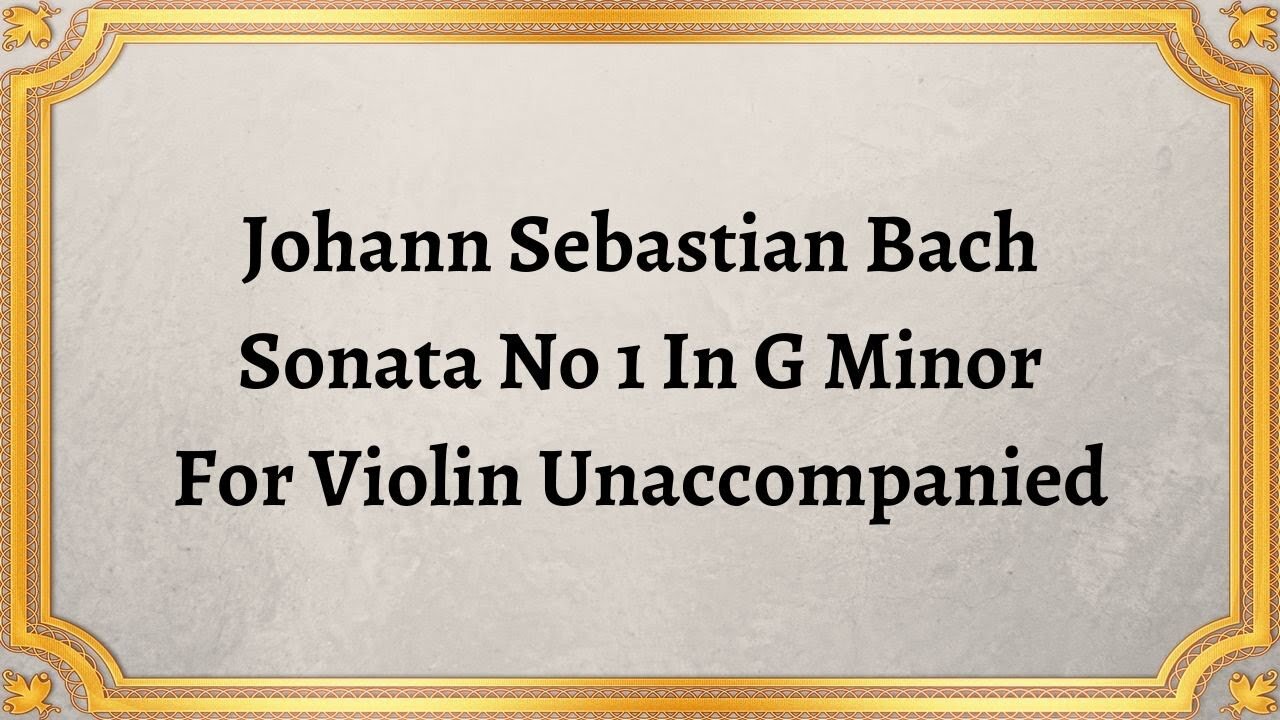Premium Only Content

Johann Sebastian Bach Sonata No 1 In G Minor For Violin Unaccompanied
#JohannSebastianBach #SonataNo1inGMinor #Violin #BaroqueEra #CounterpointTechnique #SoloRecitals #ChamberMusicConcerts #OrchestralPerformances #ClassicalMusic #MusicalComposition
Publication date 1950
Tossy Spivakovsky
Johann Sebastian Bach's Sonata No. 1 in G minor for violin is known to be one of his most popular pieces among violinists and music enthusiasts alike. Composed in the Baroque era, the sonata is characterized by its intricate melodies and harmonies, showcasing Bach's genius as a composer.
The sonata is divided into four movements - Adagio, Fuga: Allegro, Siciliano, and Presto - each with its own distinct sound and feel. The first movement, Adagio, starts with a gentle and melancholic melody that beautifully showcases the violin's tonal range and expressiveness.
The second movement, Fuga: Allegro, is a fast-paced and energetic piece that highlights Bach's mastery of counterpoint technique, where two or more independent melodies interact to create a harmonious whole. The third, Siciliano, is a slower and more contemplative piece that draws from a traditional Italian dance form. Here, Bach's incredible ability to weave together melody and harmony is evident, with the violin taking on a more prominent role.
Finally, the Presto, which is also the longest movement of the sonata, is a dazzling display of virtuosity, with the violin executing rapid-fire runs with ease and precision. The Presto is a great example of Bach's creativity in using the different elements of rhythm, tempo, and melody to create something truly magnificent.
The Sonata No.1 in G Minor has remained a favorite among violinists and musicians alike, with its popularity resulting in several adaptations for different instruments, including the piano, harpsichord, and cello. The piece is frequently performed in solo recitals, chamber music concerts, and orchestral performances, especially in Baroque music revival movements.
Overall, Johann Sebastian Bach's Sonata No. 1 in G minor for violin is a sonata of musical excellence that will continue to captivate audiences for generations to come. Its intricate harmonies, soaring melodies, and technical challenges are a testament to Bach's skill as a composer and his unparalleled influence on Western classical music. The piece remains a treasure trove of artistic excellence and will undoubtedly continue to inspire and impress all those who listen to it.
In conclusion, Sonata No.1 in G Minor for violin by Johann Sebastian Bach is a beautiful piece of music that showcases the composer's finesse in orchestration and melody composition. Its four movements are impressive in how they display different aspects of Bach's musical proficiency, and it is certainly one of the most popular and celebrated pieces
You have the opportunity to support the channel https://destream.net/live/RadSiarAl/donate
-
 20:26
20:26
Classical music_Music Inspiration
25 days agoJohann Sebastian Bach Orchestral Suite No. 2 in B minor, BWV 1066
692 -
 2:51:33
2:51:33
The Pascal Show
15 hours ago $0.10 earned27 DEAD, CHILDREN MISSING! Desperate Search Along Guadalupe River After Texas Floods
805 -
 2:09:35
2:09:35
Badlands Media
17 hours agoDevolution Power Hour Ep. 369: Debt Theater, Fake Elections, and Elon’s New Party Psyop
61.5K41 -
 1:17:43
1:17:43
The Connect: With Johnny Mitchell
7 hours ago $14.31 earnedCartel Hitman Reveals How The Jalisco New Generation Cartel Turned Him Into A Professional Sicario
32.1K3 -
 2:41:03
2:41:03
BlackDiamondGunsandGear
6 hours agoAfter Hours Armory / DLD & Mike w- CMMG / 4th of July Show!!
17.2K -
 2:10:37
2:10:37
Tundra Tactical
5 hours ago $17.44 earned🔫 World's Okayest Firearm Live Stream: GunCon Drama, NFA Smackdown & Silly 2A Games! 💥
56K1 -
 5:13:54
5:13:54
Cripiechuccles
7 hours ago😁💚💙SHATTERDAY WITH CRIPIE💚💙RUMLUV ACTIVATE👌COME IN AND SAY HI!!:😁
13.8K -
 2:41:03
2:41:03
DLDAfterDark
5 hours ago $4.82 earnedLet's Talk Suppressors! Feat. Mike From CMMG! The After Hours Armory!
26.6K -
 LIVE
LIVE
Reolock
9 hours agoWoW Classic Hardcore | Level and CHAT | RTMP
67 watching -
 8:00
8:00
MattMorseTV
9 hours ago $15.76 earnedHe just lost EVERYTHING.
44K41